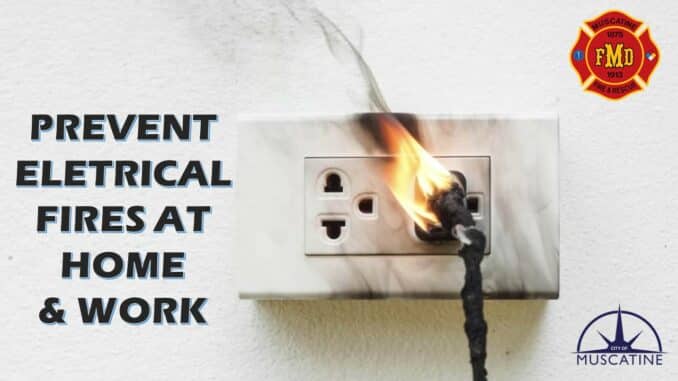
Did you know that one in seven home fires is classified as an electrical fire? Some of these fires are caused by electrical system failures and appliance defects, but many more are started by the misuse and poor maintenance of electrical appliances, incorrectly installed wiring, and overloaded circuits and extension cords. Here are some helpful tips to best guard your home against electrical fires.
Appliances
- Always plug major appliances such as refrigerators, stoves, washers, and dryers directly into a wall outlet
- Never use an extension cord with a major appliance, as it can overheat and start a fire
- Always plug small appliances directly into a wall outlet—and unplug them when you’re not using them
- Keep lamps, light fixtures, and light bulbs away from anything flammable
- Only use light bulbs that match the recommended wattage on the lamp or fixture
- Check appliance electrical cords often—and replace cracked, damaged, and loose cords
Extension Cords, Power Strips and Surge Protectors
- Replace old, worn, or damaged extension cords right away
- Only use extension cords for temporary purposes
- Avoid placing cords where they can be damaged or pinched—like under a carpet or rug
- Only use power strips that have internal overload protection
Outlets
- Do not overload wall outlets—and insert plugs fully into sockets
- Never force a three-prong cord into a two-slot outlet
- Install tamper-resistant electrical outlets if you have young children
Make sure all electrical work in your home is done by a qualified electrician!
Get additional outdoor electrical safety information from the professionals at NFPA here.
PROTECT YOURSELF FROM ELECTRICAL HAZARDS
CDC offers advice for avoiding electrical hazards, helping those injured by a shock
Avoid electrical hazards both in your home and elsewhere:
- Never touch a fallen power line. Call the power company to report fallen power lines.
- Avoid contact with overhead power lines during cleanup and other activities.
- Do not drive through standing water if downed power lines are in the water.
- If a power line falls across your car while you are driving, stay inside the vehicle and continue to drive away from the line. If the engine stalls, do not turn off the ignition. Warn people not to touch the car or the line. Call or ask someone to call the local utility company and emergency services. Do not allow anyone other than emergency personnel to approach your vehicle.
- If electrical circuits and electrical equipment have gotten wet or are in or near water, turn off the power at the main breaker or fuse on the service panel. Do not enter standing water to access the main power switch. Call an electrician to turn it off.
- Never turn power on or off yourself or use an electric tool or appliance while standing in water. Do not turn the power back on until electrical equipment has been inspected by a qualified electrician. All electrical equipment and appliances must be completely dry before returning them to service. Have a certified electrician check these items if there is any question.
- If you see frayed wiring or sparks when you restore power, or if there is an odor of something burning but no visible fire, you should immediately shut off the electrical system at the main circuit breaker.
- Consult your utility company about using electrical equipment, including power generators. Do not connect generators to your home’s electrical circuits without the approved, automatic-interrupt devices. If a generator is on line when electrical service is restored, it can become a major fire hazard and it may endanger line workers helping to restore power in your area.
If you believe someone has had electric shock take the following steps:
- Look first. Don’t touch. The person may still be in contact with the electrical source. Touching the person may pass the current through you.
- Call or have someone else call 911 or emergency medical help.
- Turn off the source of electricity if possible. If not, move the source away from you and the affected person using a non-conducting object made of cardboard, plastic or wood.
- Once the person is free of the source of electricity, check the person’s breathing and pulse. If either has stopped or seems dangerously slow or shallow, begin cardiopulmonary resuscitation (CPR) immediately.
- If the person is faint or pale or shows other signs of shock, lay him or her down with the head slightly lower than the trunk of the body and the legs elevated.
- Don’t touch burns, break blisters, or remove burned clothing. Electrical shock may cause burns inside the body, so be sure the person is taken to a doctor.
Protect Yourself and Others from Electrical Hazards After a Disaster – Centers for Disease Control and Prevention.
